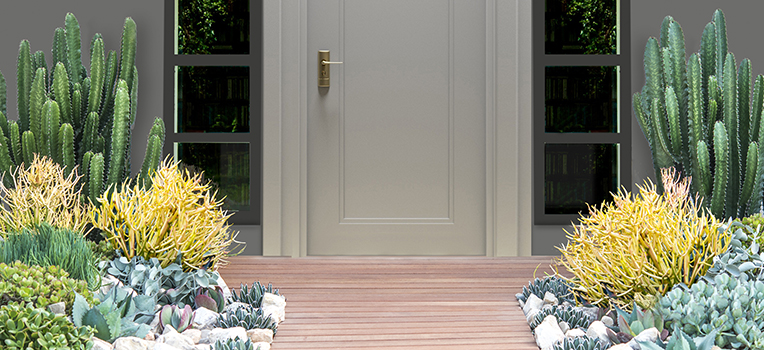Xeriscaping
If you're a keen gardener but lack time, want to save money (or you’re just plain forgetful) you'll love xeriscaping. We're so confident you'll love it, we've even created a beautiful xeriscaping garden plan to inspire you.
What is xeriscaping?
The term xeriscaping was coined by Denver Water, Colorado’s water utility, in 1981. Combining the words "landscape" and "xeros" (Greek for dry), xeriscaping is about rethinking the traditional thirsty garden and lawn, instead using stones, rocks, pebbles and drought-hardy plants that, once established, will thrive with mostly rain and little to no feeding or pruning.
But before you write off xeriscaping as little more than a rocky wasteland and a few lonely cacti, you may be surprised to learn there are many plants to choose from. As well as no-brainers like succulents and cacti, certain grasses and even lavender and rosemary all have similar water needs and can help create a beautiful xeriscape.
The benefits of xeriscaping
As with any new garden, there will be some initial costs when setting up your xeriscape, but in the long run you'll save time and money. Compared to a traditional garden, watering is minimal (once plants are established) and you won't need to spray as many chemicals or use as much fertiliser. Using pebbles and rocks also means less space for weeds to grow. In addition, with the correct amount of light, succulents tend to keep their form, so you can even put away the secateurs.
Planning your xeriscape garden
If you want to create a space for kids and pets to run around, steer clear of prickly cacti. Instead use softer succulents like Kalanchoe hildebrandtii (Kalanchoe Silver Spoon), Kalanchoe luciae (Kalanchoe ‘Flapjacks’), Echevarias, Portulacas, Carpobrotus glaucescens (Angular Pigface plant) and grasses such as Festuca glauca (Blue Fescue), Lomandra longifolia (Spiny head mat rush), Lomandra longifolia ‘Tanika’ and Pennisetum rubrum (Purple Fountain Grass). Use pavers, pebbles and decking to create an entertaining space and for contrasting features, use decorative boulders, bird baths, paths or a fire pit.
Let our xeriscape inspire yours!
We've created a xeriscape garden plan for you, based on the stunning xeriscape pictured above. It's perfect for a four by four-metre space, but feel free to adapt it to your garden and make it your own!
All the plants and materials featured can be found in our garden centres.
Click to view our xeriscape garden plan.
Our favourite xeriscaping plants
- Crassula ovata (Crassula Jade Tree)
- Euphorbia trigona (Euphorbia African Milk Tree)
- Euphorbia tirucalli (Euphorbia Fire Sticks)
- Agave attenuata hybrid (Agave Blue Glow)
- Agave victoria-reginae (Queen Victoria Agave)
- Kalanchoe luciae (Kalanchoe Flapjacks)
- Senecio mandraliscae (Senecio Blue Chalk Sticks)
- Kalanchoe hildebrandtii (Kalanchoe Silver Spoon)
Soil
Xeriscape plants like well-draining soil, but if you're adding grasses, you may want to add organic material to your soil to help with water retention.
Mulch
Mulch keeps plant roots cool and reduces evaporation and weeds. Mulches, such as woodchip can be applied at least 7.5mm deep. Mulches like rocks and gravel can be applied at least 5 centimetres deep. Mulch can be applied straight onto the soil or placed over a landscape fabric. Don’t use plastic as it stops air and water from reaching plant roots.



